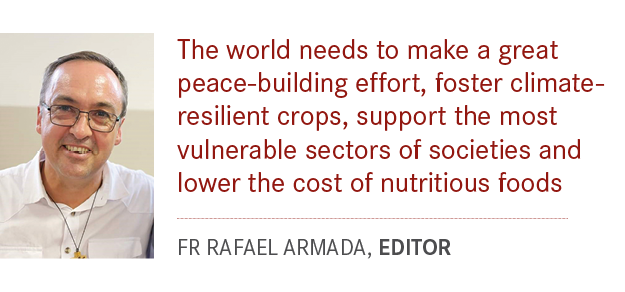EDITORIAL

Ending hunger
BY FR Rafael Armada | EDITOR
WHILE WRITING these lines, images on TV of the cruel war in Ukraine daunt us. Appalling as they are, we may nevertheless realise that this is not the only war or situation of violence currently happening in the world. Other wars often remain silent in the media despite having devastating effects among huge throngs of the global populations. Hunger—considered an ingestion lower than 1 800 calories per day—is one of them. According to UN estimates, it affected 720–811 million people in 2020, about one in 10 on earth. World agriculture produces food to provide everyone with at least 2 880 kilocalories per day, enough for all, but unfortunately, more than 30% goes to waste. The number of hungry people is on the rise—roughly 70–161 million more in 2020 than in 2019. However, its proportion to population varies according to regions, being the highest in Africa, with an estimated 22% of its peoples.
The 2021 State of Food Security and Nutrition in the World report—a collaboration between UN agencies—outlines three major causes of the recent rise in hunger and food insecurity: conflict (the primary reason for 99.1 million people in 23 countries in 2020); climate variability and extremes; and economic slowdowns and downturns (exacerbated by the COVID-19 pandemic).
We still do not know the impact the war in Ukraine will have, particularly in Africa, but looking at the volume of grain imported from Ukraine and Russia and the current increase in fertilizer prices, makes us presume that it will be important. “Half the world’s population gets food as a result of fertilizers. If that’s removed from the field for some crops, [the yield] will drop by 50%”, according to Svein Tore Holsether, President of Yara International. The second of UN’s 17 Sustainable Development Goals, namely eliminating hunger by 2030, will face another setback.
These situations and their challenges call for a transformation of food systems. UN agencies consider six ways to ensure access to affordable healthy diets for all, sustainably and inclusively. According to them, the world needs to make a great peace-building effort, foster climate-resilient crops, support the most vulnerable sectors of societies and lower the cost of nutritious foods. Poverty and structural inequalities are an obstacle to healthier diets.
Many of our current food systems favour monocultures, highly dependent on fertilizers and commercial seeds, vulnerable to global price fluctuations of commodities. Big corporations and retailers dominate and control worldwide prices. Small farmers, herders, and fishermen who produce about 70% of the global food supply, are exposed to food insecurity, with poverty and hunger most acute among rural populations.
Looking at the condition of children—an estimated 14 million under the age of five—who suffer from severe acute malnutrition worldwide, South Africa is not exempt from this reality. Child stunting, a so-called ‘slow violence’, remains at a high rate of 27% and it has not decreased over the last 20 years. This is a worrying situation since stunting, particularly in the first 1 000 days of the life of a child, hinders brain development with associated cognitive impairment, weakens their immune system and jeopardizes their full potentialities. At the same time, 13% of South African children under five years are overweight or obese. The high prevalence of malnutrition, manifested both as undernourishment and obesity, clearly indicate the need for healthier and more nutritious ways of life.
Grass-root initiatives, some portrayed in this issue, show that a different way of obtaining food is possible and we can combat malnutrition by producing locally and in a sustainable way.
Lent is a time when we reflect upon realities of suffering in the world—conflict and hunger are two of them—though always with an outlook of hope. While we question ourselves about the causes of suffering, we try to sympathize with the victims and find ways to respond to their plight. We remain with our eyes fixed on Jesus who stood for truth, endured injustice perpetrated against Him and gave His life to show us the way to glory, through His Passion, Death and Resurrection. Happy Easter!
| Dates To Remember |
|
April 2 – World Autism Awareness Day 4 – International Day for Mine Awareness and Assistance in Mine Action 6 – International Day of Sport for Development and Peace 7 – International Day of Reflection on the 1994 Genocide in Rwanda 7 – World Health Day 15 – Good Friday 17 – Easter Sunday 21 – World Creativity and Innovation Day 22 – International Mother Earth Day 23 – English & Spanish Language Day 24 – International Day of Multilateralism and Diplomacy for Peace 25 – World Malaria Day 28 – World Day for Safety and Health at Work 30 – Our Lady, Mother of Africa 30 – International Jazz Day May 1 – St Joseph the Worker, Workers’ Day 3 – World Press Freedom Day 8 – Remembrance and Reconciliation for Victims of Second World War 8 – World Migratory Bird Day 15 – International Day of Families 17 – World Telecommunication and Information Society Day 20 – World Bee Day 21 – World Day for Cultural Diversity for Dialogue and Development 22 – International Day for Biological Diversity 29 – Ascension of the Lord 29 – International Day of UN Peacekeepers 30 – World No-Tobacco Day |
